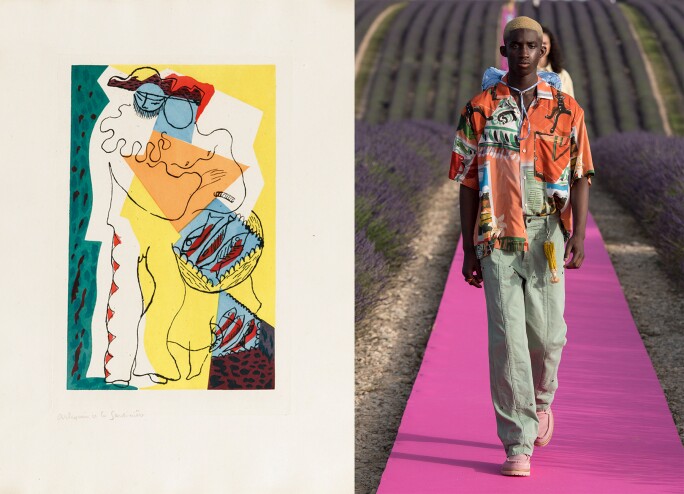O n Monday, Simone Porte Jacquemus presented a 65-look unisex collection on a hot pink runway in the South of France, just miles away from the designer’s hometown. The open-air show celebrated the brand’s 10th anniversary amidst a lavender lined vision of Valensole, Provence.
Redolent of idyllic pastoral scenes painted by Paul Cézanne and other post-Impressionists, the designer upended its traditional image with his own quirk by marrying in the Pop element of David Hockney landscapes and Christo installations. “A painting within a painting, in a field. Provençal Pop!” Jacquemus tells Vogue Runway. This is a dream come true for us.
His collection is a series of ‘madcap’ characters: overdressed vacationers and artists mismatching, scribbly field flower prints and trompe-l’oeil motifs in a sunburned (“Le Coup de Soleil”) palette. Art imitates life imitates art, and so forth. Below, we’ve taken the liberty to playfully assess which paintings may have inspired our favorite Jacquemus looks.
Hot Hockney Pink

Hockney’s The Arrival of Spring in Woldgate, East Yorkshire was painted en plein air like the Impressionists before him, which served as a reference point for Porte’s fashion show. Often revisiting his bucolic childhood home of East Yorkshire, Hockney painted vibrantly hued landscapes of fields that rolled towards the horizon, marked by swirly lines evocative of Vincent Van Gogh’s. He proclaimed his love for his countryside origins, like Porte, yet at the same time, sunbathed in the influence of their respective adopted homes – Californian sunshine and a youthful Parisian spirit. In Double East Yorkshire, 1998, shown above, Hockney inlays a pink path within his Arcadian landscape, stretching across two expansive canvases joined together.
Ode to the Post-Impressionists

Jacquemus’s pastoral trompe-l’oeil scene inset on this oversized shirt is another painting within a painting. We’re reminded of Cézanne's earlier period of heavy brushstrokes, but also of the pastel colors and French farmlands, seen in his later work, Environs de gardanne. Note also Paul Gauguin’s very detailed Les mas, environs d’Arles – another post-Impressionist masterpiece of the region.
Granita-flavored Hues

This rare first edition Jean Lurçat etching pictures two embracing Harlequin characters and a basket of fish. Jacquemus’s version appears in bold appliances of brushstrokes and a use of saturated colors that clash in refreshing Granita-flavored colors, added with dabs of mint and window side views of the countryside.
Bathing in Pastel

Here, we look to Neo-Impressionist work, À l'ombre des pins, painted by Théo van Rysselberghe, who set to capture bathers amidst a palette of soft pinks, purples, and oranges. For Porte, this was achieved through an ombre and clever styling of a lavender colored filt net bag over his model’s chest. We end with Léo Gausson, Paysage en Provence, a bucolic paradise.
Image credit: courtesy of JACQUEMUS.


